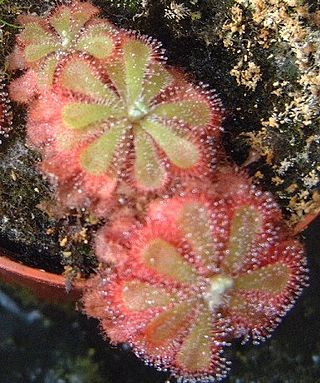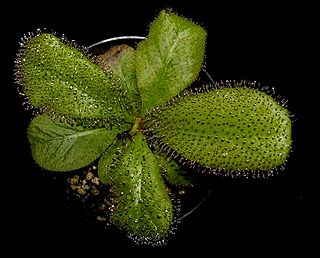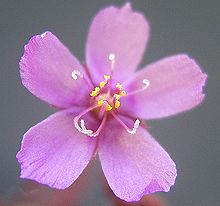
Drosera, which is commonly known as the sundews, is one of the largest genera of carnivorous plants, with at least 194 species. These members of the family Droseraceae lure, capture, and digest insects using stalked mucilaginous glands covering their leaf surfaces. The insects are used to supplement the poor mineral nutrition of the soil in which the plants grow. Various species, which vary greatly in size and form, are native to every continent except Antarctica.

Droseraceae is a family of carnivorous flowering plants, also known as the sundew family. It consists of approximately 180 species in three extant genera. Representatives of the Droseraceae are found on all continents except Antarctica.

Drosera capillaris, also known as the pink sundew, is a species of carnivorous plant belonging to the family Droseraceae. It is native to the southern United States, the Greater Antilles, wastern and southern Mexico, Central America, and northern South America. It is listed as vulnerable in the US state of Virginia, and critically imperiled in Arkansas, Maryland, and Tennessee.

Drosera aliciae, the Alice sundew, is a carnivorous plant in the family Droseraceae. It is native to the Cape Provinces of South Africa, like Drosera capensis, the cape sundew, and is one of the most common sundews in cultivation. The plant forms small, tight rosettes of wedge-shaped leaves, up to 5 cm in diameter. Under conditions of good lighting, the insect-snagging tentacles will become deeply coloured with anthocyanin pigments, which probably aid in its attraction of insect prey. The plant is relatively easy to grow, and produces attractive scapes of pink flowers, which are held about 30 cm away from the carnivorous leaves, so as to prevent pollinators from becoming ensnared. D. aliciae is very similar in form to a number of other closely related species such as D. slackii, and D. natalensis: the former is rather larger with a slightly different growth habit(8 cm diameter); the latter has hairier stipules and a larger distance between leaf base and the “sticky” trichomes.

Drosera capensis, commonly known as the Cape sundew, is a small rosette-forming carnivorous species of perennial sundew native to the Cape in South Africa. Because of its size, easy to grow nature, and the copious amounts of seed it produces, it has become one of the most common sundews in cultivation, and thus, one of the most frequently introduced and naturalised invasive Drosera species.

Drosera rotundifolia, the round-leaved sundew, roundleaf sundew, or common sundew, is a carnivorous species of flowering plant that grows in bogs, marshes and fens. One of the most widespread sundew species, it has a circumboreal distribution, being found in all of northern Europe, much of Siberia, large parts of northern North America, Korea and Japan but is also found as far south as California, Mississippi and Alabama in the United States of America and in New Guinea.

Drosera peltata, commonly called the shield sundew or pale sundew, is a climbing or scrambling perennial tuberous species in the carnivorous plant genus Drosera. Among the tuberous sundews, D. peltata has the largest distribution, which includes eastern and western Australia, New Zealand, India, and most of Southeast Asia including the Philippines. The specific epithet is Latin for "shield shaped", a reference to the shape of the cauline leaves. It is either a single extremely variable species, or a complex of several closely related species of uncertain taxonomic boundaries. In Australia at least four forms have had or still have specific taxonomic recognition: Drosera peltata subsp. peltata, D. peltata subsp. auriculata, D. foliosa and D. gracilis.

Drosera binata, commonly known as the forked sundew or fork-leaved sundew. It is a large, perennial sundew native to Australia and New Zealand. The specific epithet is Latin for "having pairs" - a reference to the leaves, which are dichotomously divided or forked.

Drosera indica is an insectivorous plant, a sundew native to tropical countries throughout the world, from Asia to Africa, but absent from the neotropics. Together with Australian endemic species D. aquatica, D. aurantiaca, D. barrettorum, D. cucullata, D. finlaysoniana, D. fragrans, D. glabriscapa, D. hartmeyerorum, D. nana, D. serpens it makes up the section Arachnopus.

Drosera platypoda, the fan-leaved sundew, is a tuberous perennial species in the genus Drosera that is endemic to south-west Western Australia. It grows 15 to 20 cm tall with a basal rosette of leaves with alternate cauline leaves along the stem. It is native to a region from Manjimup south-west to an area around the Scott River and east to Cape Riche. It grows in winter-wet sandy soils in heathland. It flowers in October.

Drosera ramellosa, sometimes referred to as the branched sundew, is a tuberous perennial species in the genus Drosera that is endemic to Western Australia. It was first formally described by Johann Georg Christian Lehmann in 1844. It was again described by Jules Émile Planchon as Drosera penduliflora in 1848, which was reduced to synonymy under D. ramellosa in 1864 by George Bentham.

Drosera macrophylla, the showy sundew, is a perennial tuberous species in the genus Drosera that is endemic to Western Australia. It grows in a rosette with leaves 4 cm (2 in) long and 2 cm (1 in) wide. It is a common species east of Perth. It grows in loam soils. It flowers from June to October. D. macrophylla was first described by John Lindley in his 1839 publication A sketch of the vegetation of the Swan River Colony. In 1992, Allen Lowrie and Sherwin Carlquist described a new subspecies, D. macrophylla subsp. monantha, which is distinguished from D. macrophylla subsp. macrophylla by its single-flowered or rarely biflowered inflorescences. Subspecies monantha is abundant in the Bruce Rock/Merredin region.

Drosera schizandra is a species of Drosera found in Queensland, Australia. Commonly called the notched sundew or heart-leaf sundew, it has round, oval leaves that sometimes develop notched tips as they grow, giving them a heartlike shape.

Drosera andersoniana, the sturdy sundew, is an erect perennial tuberous species in the genus Drosera that is endemic to Western Australia. It produces a basal rosette of leaves similar to that of D. peltata and the stem grows to 8–25 cm (3–10 in). Its pink-white to red flowers emerge from August to September. D. andersoniana grows in loamy soils near granite outcrops.
Drosera sulphurea, the sulphur-flowered sundew, is a scrambling perennial tuberous species in the carnivorous plant genus Drosera. It is endemic to Western Australia and is found in coastal areas in sandy loam, often among Cephalotus. D. sulphurea produces small, shield-shaped carnivorous leaves along stems that can be 40–60 cm (16–24 in) high. Yellow flowers bloom in September.

Drosera glanduligera, commonly known as the pimpernel sundew or scarlet sundew, is a species of carnivorous plant endemic to southern Australia. It is an ephemeral annual plant that grows in the winter and flowers from August to November.

Drosera meristocaulis is a perennial species in the carnivorous plant genus Drosera, the only member of the subgenus Meristocaulis. It is a small, rosette- and branched stem-forming sundew that has many morphological affinities to the Australian pygmy sundews. D. meristocaulis is wholly endemic to Pico da Neblina, an isolated mountain on the Brazil-Venezuela border.
Drosera peruensis is a carnivorous plant of the genus Drosera, commonly known as the Peruvian sundew. This Drosera species was first identified in Peru in 2002 by Tânia Regina dos Santos Silva and Mireya D. Correa following work to update the genus Drosera for the reference text, Flora Neotropica..

Drosera kaieteurensis is a plant from the sundew family (Droseraceae).

Drosera admirabilis, commonly referred to as the "floating sundew", is in the carnivorous us plant family Droseraceae. The nickname "admirabilis" was first used in literature by Paul Debbert in 1987 and was derived from how "admirable" the plant appears when it reaches a fully matured specimen. Structurally similar to Drosera aliciae, and Drosera cuneifolia, the D. admirabilis grows in a single tight rosette-shaped leaf bundle. The leaves widen towards the end and have rounded tips. Leaves lay horizontally under proper lighting conditions. Like many other African sundews, D. admirabilis is a perennial. D. admirabilis has outer tentacles like those of Drosera glanduligera, Drosera sessilifolia and Drosera burmannii which briefly after stimulation bend towards the prey.



















